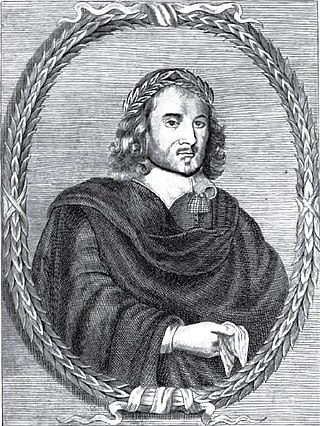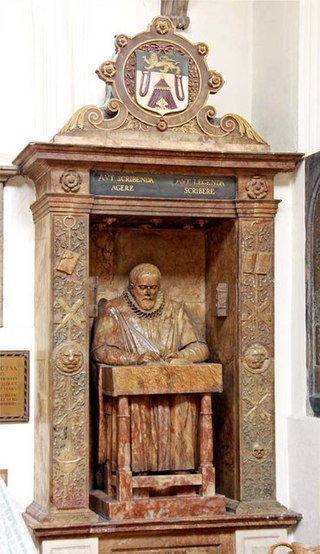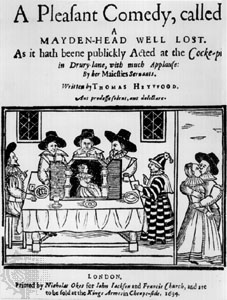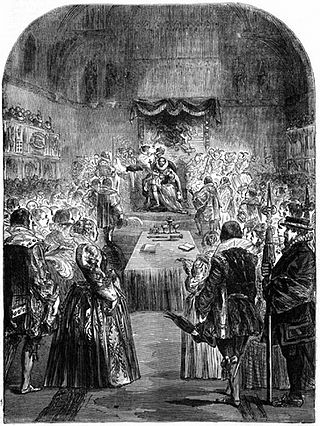Related Research Articles

Thomas Middleton was an English Jacobean playwright and poet. He, with John Fletcher and Ben Jonson, was among the most successful and prolific of playwrights at work in the Jacobean period, and among the few to gain equal success in comedy and tragedy. He was also a prolific writer of masques and pageants.
This article presents lists of the literary events and publications in 1603.
This article contains information about the literary events and publications of 1601.

John Stow was an English historian and antiquarian. He wrote a series of chronicles of English history, published from 1565 onwards under such titles as The Summarie of Englyshe Chronicles, The Chronicles of England, and The Annales of England; and also A Survey of London. A. L. Rowse has described him as "one of the best historians of that age; indefatigable in the trouble he took, thorough and conscientious, accurate – above all things devoted to truth".

Thomas Dekker was an English Elizabethan dramatist and pamphleteer, a versatile and prolific writer, whose career spanned several decades and brought him into contact with many of the period's most famous dramatists.
Henry Chettle was an English dramatist and miscellaneous writer of the Elizabethan era, best known for his pamphleteering.

Thomas Heywood was an English playwright, actor, and author. His main contributions were to late Elizabethan and early Jacobean theatre. He is best known for his masterpiece A Woman Killed with Kindness, a domestic tragedy, which was first performed in 1603 at the Rose Theatre by the Worcester's Men company. He was a prolific writer, claiming to have had "an entire hand or at least a maine finger in two hundred and twenty plays", although only a fraction of his work has survived.
Anthony Munday was an English playwright and miscellaneous writer. He was baptized on 13 October 1560 in St Gregory by St Paul's, London, and was the son of Christopher Munday, a stationer, and Jane Munday. He was one of the chief predecessors of Shakespeare in English dramatic composition, and wrote plays about Robin Hood. He is believed to be the primary author of Sir Thomas More, on which he is believed to have collaborated with Henry Chettle, Thomas Heywood, William Shakespeare, and Thomas Dekker.

Elizabethan literature refers to bodies of work produced during the reign of Queen Elizabeth I (1558–1603), and is one of the most splendid ages of English literature. In addition to drama and the theatre, it saw a flowering of poetry, with new forms like the sonnet, the Spenserian stanza, and dramatic blank verse, as well as prose, including historical chronicles, pamphlets, and the first English novels. Major writers include William Shakespeare, Edmund Spenser, Christopher Marlowe, Richard Hooker, Ben Jonson, Philip Sidney, and Thomas Kyd.
Richard Hathwaye, was an English dramatist.
The Admiral's Men was a playing company or troupe of actors in the Elizabethan and Stuart eras. It is generally considered the second most important acting troupe of English Renaissance theatre.
Valentine Simmes was an Elizabethan era and Jacobean era printer; he did business in London, "on Adling Hill near Bainard's Castle at the sign of the White Swan." Simmes has a reputation as one of the better printers of his generation, and was responsible for several quartos of Shakespeare's plays. [See: Early texts of Shakespeare's works.]
The Archpriest Controversy was the debate which followed the appointment of an archpriest by Pope Clement VIII to oversee the efforts of the Roman Catholic Church's missionary priests in England at the end of the sixteenth century.
Thomas Creede was a printer of the Elizabethan and Jacobean eras, rated as "one of the best of his time." Based in London, he conducted his business under the sign of the Catherine Wheel in Thames Street from 1593 to 1600, and under the sign of the Eagle and Child in the Old Exchange from 1600 to 1617. Creede is best known for printing editions of works in English Renaissance drama, especially for ten editions of six Shakespearean plays and three works in the Shakespeare Apocrypha.
Edward Allde was an English printer in London during the Elizabethan and Jacobean eras. He was responsible for a number of significant texts in English Renaissance drama, including some of the early editions of plays by William Shakespeare.
Joseph Gillow was an English Roman Catholic antiquary, historian and bio-bibliographer, "the Plutarch of the English Catholics".
Ellis Gibbons was an English composer of the late Renaissance who was associated with the English Madrigal School. Born in Cambridge to a musical family, Gibbons was the second surviving son of William Gibbons, a town wait. By 1598 he was known to be living in Cambridge's High ward, and later the Market ward. He owned property in Cambridge and London and probably spent much time there, presumably as a musician of some kind. At the age of 28 he became one of only two composers to contribute two pieces to The Triumphs of Oriana, a collection of 25 madrigals published in 1601. These madrigals were Long live faire Oriana and Round about her Charret; modern commentators generally favor the latter. No other compositions by Gibbons survive, and some scholars have doubted his authorship of these works, ascribing them to his brothers. Two months after his mother's death, his career was cut short by his early death in May 1603, leaving behind his brothers Edward, Ferdinando and Orlando, who would become the most famous musician of the family. Orlando's son, Christopher, was also a noted composer.

Frank Percy Wilson was a British literary scholar and bibliographer. Author of many works on Elizabethan drama and general editor of the Oxford History of English Literature, Wilson was Merton Professor of English Literature at the University of Oxford from 1947 to 1957.
The Governor of Pendennis Castle was a military officer who commanded the fortifications at Pendennis Castle, part of the defences of the River Fal and Carrick Roads, on the south coast of Cornwall near Falmouth. Originally fortified under Henry VIII, defences in the area were intermittently maintained until after the Second World War. The office of governor was abolished in 1837, when Gen. Anderson received the colonelcy of the 78th Regiment of Foot.

The 1603 London plague epidemic was the first of the 17th century and marked the transition from the Tudor to the Stuart period.
References
- ↑ Twyning, John. "Dekker, Thomas (c. 1572-1632), playwright and pamphleteer." Oxford Dictionary of National Biography. February 20, 2018.
- 1 2 3 Bayman, Anna. Thomas Dekker and the Culture of Pamphleteering in Early Modern London. Farnham, Surrey: Ashgate, 2014, page 68.
- ↑ "wonderful, adj. (and n.) and adv." OED Online. January 2018. Oxford University Press. (Accessed March 2018).
- ↑ Dekker, Thomas. The Non-Dramatic Works of. Thomas Dekker: In Five Volumes, Volume 1. 1598-1603. Accessed from Google Books, p. 86. "made him his Herauld"
- ↑ Dekker, Thomas. The Non-Dramatic Works of. Thomas Dekker: In Five Volumes, Volume 1. 1598-1603. Accessed from Google Books, p. 86: "tooke away hearts from millions"
- ↑ Dekker, Thomas. The Non-Dramatic Works of. Thomas Dekker: In Five Volumes, Volume 1. 1598-1603. Accessed from Google Books, 93.
- ↑ Jones, Emily Griffiths. "Hereditary Succession and Death in The Wonderful Year and the Revenger's Tragedy." SEL: Studies in English Literature 1500–1900, no. 56, vol 2. (2016): p. 327+, 332.
- ↑ Bayman, Anna. Thomas Dekker and the Culture of Pamphleteering in Early Modern London. Farnham, Surrey: Ashgate, 2014. Page 131.
- ↑ Dekker, Thomas. The Non-Dramatic Works of. Thomas Dekker: In Five Volumes, Volume 1. 1598-1603. Accessed from Google Books, Page 95.
- ↑ Dekker, Thomas. The Non-Dramatic Works of. Thomas Dekker: In Five Volumes, Volume 1. 1598-1603. Accessed from Google Books, 97.
- ↑ Dekker, Thomas. The Non-Dramatic Works of. Thomas Dekker: In Five Volumes, Volume 1. 1598-1603. Accessed from Google Books, 105.
- ↑ Dekker, Thomas. The Non-Dramatic Works of. Thomas Dekker: In Five Volumes, Volume 1. 1598-1603. Accessed from Google Books, 106.
- ↑ Dekker, Thomas. The Non-Dramatic Works of. Thomas Dekker: In Five Volumes, Volume 1. 1598-1603. Accessed from Google Books, 145.